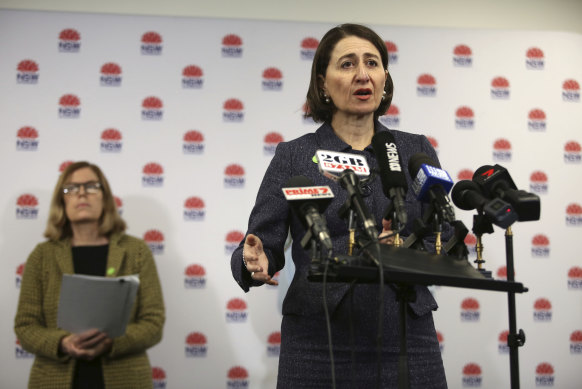Volunteers honoured for COVID-19 data crunching

Save articles for later
Add articles to your saved list and come back to them any time.
It has been one of the biggest events this century, but in March 2020, when Australians started searching online for official information about the latest COVID-19 cases, they were often disappointed.
“I thought there would be a real-time feed of every case as it was being announced,” said data analyst Anthony Macali. “What I found was there was hardly anything at all. The federal [government] dashboard was updating maybe once a day, but it was three or four hours behind.”
Anthony Macali volunteered many thousands of hours to make COVID data more easily accessible.Credit: Simon Schluter
From his bedroom in Oak Park, in Melbourne’s north, as he adjusted to working from home, Macali decided to begin finding and collating the data himself. It was a task that, for a long time, involved tuning into lengthy, hastily called press conferences and monitoring surprise social media posts.
“I started off just collecting data in a spreadsheet and sharing it on Twitter. Then a couple of weeks later, I built a basic website with just case numbers and test numbers,” the 38-year-old said.
“It was almost a full-time job, just because the press conferences were at all different times across the country. So [then-NSW premier] Gladys [Berejiklian] would come out at eight in the morning to announce her numbers, and Tasmania would be a Facebook post at 7pm.”
The high demand for a reliable and central source of up-to-date COVID-19 figures was so high that for at least a year, more than 100,000 people were visiting Macali’s website, COVID Live, daily.
Then-NSW premier Gladys Berejiklian gives a COVCID update in 2020. Data analysts had to track press conferences to learn the latest COVID numbers.Credit: James Alcock
When Macali was made redundant in 2021 from his job analysing sales data, he put advertisements on his website and was able to generate enough income to keep the project going and replace his lost income.
On Monday, the data analyst was recognised for his thousands of hours of volunteer work with a Medal of the Order of Australia (OAM) in the General Division.
A similar website to Macali’s, covid19data.com.au, also earned Sydney journalist and author Juliette O’Brien an OAM on Monday for her service to journalism and community health.
A third independent COVID-19 data website, CovidBase AU, was created by three teenage boys from Melbourne, who revealed their identities in 2021.
Juliette O’Brien, pictured in 2021, has been honoured for her services to journalism and community work.Credit: Renee Nowytarger
O’Brien said the information Australians were interested in constantly changed throughout the first years of the pandemic. But often governments were slow, or unwilling, to provide detailed data to help people understand what was happening in their communities.
One of the pages O’Brien said garnered many viewers on her website in 2020 contained a big data set tracking Victoria’s various second wave clusters. At first, she said, “the only way to track them was to listen to [Victorian Chief Health Officer] Brett Sutton reading them out”.
“It was just grunt work – it’s not that I’m some data genius,” O’Brien, also a university lecturer, said.
The sharing of government data in Australia was so poor at times, Macali said, that in early 2021, the federal government, which was leading the vaccine rollout, possibly inadvertently used the vaccine uptake data from his website in a public presentation.
“Very early on, it was really hard to get vaccine data, especially second doses,” Macali said.
As a result, he was again updating his website with scraps of public information. Perhaps numbers presented in a press conference by then-prime minister Scott Morrison or at an update by the then-health minister Greg Hunt.
The data on Macali’s website was then being used by global COVID data sites, including Our World in Data, which is how, he said, it ended up being then used by the federal government as part of its presentation.
It was clearly not just ordinary Australians relying on the data, said O’Brien, 39, who relied on donations to keep her website running. She said she received emails from people working for supermarket giant Woolworths, outdoor clothing brand Kathmandu and investment company J.P. Morgan seeking to download data sets.
“A lesson that I learnt is that the raw data, without a story around it, is still valuable for people,” she said.
Macali’s website has had almost 21.5 million users, and the number of daily visits reached close to 300,000 on three occasions; in the first few months of the pandemic, at the end of the 2021 as Victoria, NSW and the ACT were approaching key vaccination milestones to get them out of lockdown, and during the following Omicron wave.
Viewer numbers have steadily declined from the beginning of 2022 and Macali has been unable to make an income from the site since spring, when governments moved from daily to weekly reporting of COVID cases.
However, Macali’s website is still regularly updated and has thousands still visiting daily. He and O’Brien are working on a new project tracking new types of data, such as climate emissions.
The Morning Edition newsletter is our guide to the day’s most important and interesting stories, analysis and insights. Sign up here.
Most Viewed in National
From our partners
Source: Read Full Article


